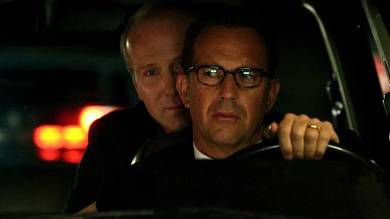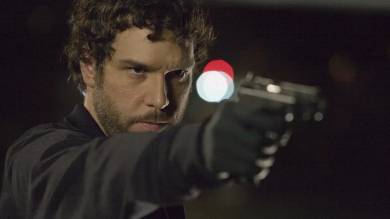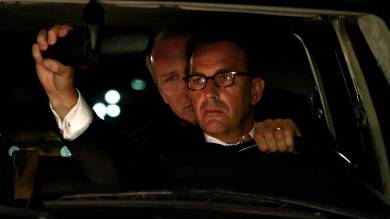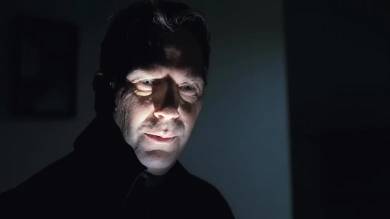Who can recall “Mr. Brooks”? This bloated curiosity left the theatres in 2007 to mixed reviews and mediocre box office receipts before swiftly fading from public memory. I saw the movie when it originally came out on DVD, but I have to admit that at the time, it didn’t have a big impact on me. But now that “Mr. Brooks” is available to stream on Amazon Prime Video, I was intrigued enough to see this peculiarity again. I’m so glad I did. This is not a story about how “Mr. Brooks” is some misunderstood masterpiece; an unfairly mistreated work of art that we all failed, let me be very clear before we move on. No, no. There are many problems with “Mr. Brooks.” The kitchen sink attitude taken here, though, is one that I can’t help but find appealing. The Ben Affleck action flick “The Accountant” is most likely the most current equivalent to this Kevin Costner film. Not because the stories in “Mr. Brooks” and “The Accountant” are the same, but rather because both movies are crammed with several subplots. Nothing is streamlined; rather, it appears that the screenwriters used any and all ideas that came to them while writing the script. Respect must be shown for that. I feel.
When you look into the movie’s history and discover that it was intended to be the first in a trilogy, the bloated nature of “Mr. Brooks” becomes even more puzzling. “Mr. Brooks” contains enough action to fill five separate films, but there was still more to come. Sadly, that trilogy will never be made, so all we have left is the first movie in all its wacky beauty. Kevin Costner gives a rare evil portrayal in “Mr. Brooks,” co-written and directed by Bruce A. Evans, whose sole other film directing credit was the Christian Slater comedy “Kuffs” from 1992. Costner doesn’t portray evil people very often, which may make him seem like an unexpected choice to play a serial killer. He has a charm reminiscent of the Midwest and an innate rigidity. But what do most people say about true serial killers once they’ve been apprehended? He seemed to be so typical.
The serial killer subgenre had been well exhausted by the time “Mr. Brooks” debuted, with most movies of the time consistently following David Fincher’s ground-breaking “Seven” as their model. However, “Mr. Brooks” makes the killer the primary character and plunges us into his double existence in an attempt to try something different. By day, Earl Brooks (Costner) runs a successful business, serves as a leader in his neighbourhood, and is a devoted husband and father. By night, he assumes the identity of the notorious Thumbprint Killer, a serial killer who presents his victims in creative postures. That notion isn’t really fresh or unique. But what “Mr. Brooks” achieves with that straightforward framework is what really makes movie shine. So join me as I explore the numerous intricacies and subplots that distinguish the delightfully absurd “Mr. Brooks” as something exceptional.
Dane Cook Is in This, and He’s Actually Pretty Good
He tried to turn his enormous popularity as a stand-up comedian, who was well-known everywhere, into a career in acting. The stand-up work eventually dried up because that didn’t go as well as his stand-up career (especially after it started to look like Cook allegedly stole a lot of his material from Louis C.K.). While most of Cook’s film performances were comic, “Mr. Brooks” gave him the opportunity to embrace a darker side. And what about that? He’s actually pretty good here! Cook portrays Mr. Smith, a complete weirdo who, at the beginning of the movie, happens to see Mr. Brooks murder a couple. Instead of fleeing to the police, Mr. Smith finds Mr. Brooks and offers to keep his true identity a secret in exchange for Mr. Brooks accompanying him on his subsequent killing. Mr. Smith acknowledges that he “got off” on watching Mr. Brooks kill people and that he is eager to learn all there is to know about turning into a serial murderer. Mr. Brooks is understandably hesitant to mentor this dishonest young man, but he goes along with it—at least initially. Cook gives a jittery and unsettling portrayal in this film, and although though he cracks a lot of jokes, he manages to pass for a pervy would-be killer. Oh, and at one point he pees in his trousers. Cinema!
Demi Moore Is a Millionaire Homicide Detective Going Through a Messy Divorce
Even though the serial killer is the main character in “Mr. Brooks,” there is still a law enforcement figure working the case. That would be Demi Moore’s portrayal of Detective Tracy Atwood. However, “Mr. Brooks” makes the extremely bizarre choice to make Detective Atwood a multimillionaire rather than just having a typical cop persona. She is said to be valued almost $60 million at one point, which is absolutely ridiculous. This strategy is justified by the fact that the protagonist is hunting down killers for fun rather than because she needs to earn a living. Despite her attempts to have Detective Atwood imprisoned, Mr. Brooks ends up respecting her because of this. Additionally, “Mr. Brooks” includes a side story about Atwood going through a difficult divorce as if the entire “rich cop” thing wasn’t already enough. Her ex-husband demands a sizable sum of money from her because she is so obscenely wealthy. However, Atwood is “only” prepared to make a settlement offer of slightly more than $1 million. I believe we’ve all been there. Each of us has been a rich detective forced to settle scores with an ex. Anyway, Mr. Brooks makes the decision to give the detective a break and tell her nasty ex to get lost, so there.
Demi Moore Uses This Phone at One Point
Even though it’s really trivial, when Demi Moore glances at a very old Nokia phone in the movie, I couldn’t help but chuckle out loud. Observe that creature! This phone could be recognisable to you because Kelly Rowland uses it in the “Dilemma” music video. The former member of Destiny’s Child is not only using the phone in question, but she is also receiving a text message using Microsoft Excel. Unfortunately, Demi Moore doesn’t text using Excel, but for some reason, her text messages do feature a large, old subject line and a signature that looks like an email.
Mr. Brooks’ Daughter Is a Murderer, Too
Jane Brooks, the daughter of Mr. Brooks (played by Danielle Panabaker), arrives home from school near the opening of the movie. She reveals that she has left college and is pregnant. Her deepest secrets, though, are not those. No, it comes out that Jane used an axe to murder someone on campus just before quitting school. Because Mr. Brooks is a brilliant guy, he can figure this out on his own. He thinks about reporting his daughter to the police at one point in order to prevent her from following in her father’s footsteps and becoming a serial killer. He later has a change of heart, though, and aids in covering up Jane’s crime. The movie concludes with Jane killing Mr. Brooks with a last surprise! I kid you not! All of that was a dream. It turns out that the movie’s initial resolution was the scene in which Jane stabs Mr. Brooks. This thus prepared the ground for a sequel in which Jane would take on the name “Ms. Brooks.” Test audiences, on the other hand, despised this, so everyone shrugged and added an extra scene that reveals the stabbing was all a dream.
Bruce A. Evans, the film’s director, claims that Mr. Brooks would not have died from the stabbing. Instead, when he made a comeback in the sequel, he would have to deal with kidnappers who had taken his family hostage for an unknown reason. In order to find his family, Brooks would team up with Detective Atwood in this scenario. Marshall would also travel with them. However, there was a time when Brooks would pretend to “kill” Marshall, only for the phantom to come back “angrier and more perverse.” Sadly, none of this materialised, and there will always be a huge void where the entire “Mr. Brooks” trilogy should have been. However, this first film, with all of its beautiful silliness, will always exist.
Marshall, however, gives into Brooks’ homicidal tendencies, in contrast to most people who are guided by their consciences to do good.
It’s unclear exactly how Marshall operates because, at one point, he describes himself as “living.” Marshall, however, is invisible to others, making him the Hobbs to Brooks’ Calvin. This leads to numerous instances where Costner and Hurt converse inaudibly to other characters. All of this is not meant to imply that Marshall must coerce Brooks into killing. No, there are several instances in this where Marshall and Mr. Brooks are in agreement and laughing out loud as they come up with a bizarre scheme together. The best part is that “Mr. Brooks” never tries to con us. In a worse version of the film, Marshall’s true identity as an invisible, imaginary friend is not revealed until a major twist in the third act. In this case, it is immediately apparent that Marshall only exists in Mr. Brooks’ shattered mind.
Mr. Brooks Has an Imaginary Friend Played by William Hurt
The most intriguing aspect of “Mr. Brooks” is William Hurt’s portrayal of Marshall, who is essentially just enjoying himself immensely while chewing the scenery as Mr. Brooks’ imaginary companion. Hurt and Costner are an unusual acting duo, and although Costner (usually) plays Brooks straight, Hurt gets to play Marshall, who is more of a fun character to see. Brooks “met” Marshall when he was a young child, and the two had been together ever since, according to deleted sequences. But the movie starts with the following text displayed on screen to simplify things for the theatrical cut: “The hunger is back in Mr. Brooks’ mind. It never truly vanished.” I think title cards like this should appear at the beginning of every movie.
Mr. Brooks: Master of Disguise!
Because of his meticulous planning, Mr. Brooks even has a large collection of theatrical disguises.
Late in the movie, Brooks must go to carry out a murder outside of his home state; to conceal his identity, he dons a variety of wigs and fake beards.
At one point, he even uses a cane to walk. While none of this is credible, it is entertaining to see Kevin Costner attempt to maintain his fake moustache while having a bloody wedding.
Mr. Brooks Is Addicted to Murder
The notion that the titular character of “Mr. Brooks” treats his propensity for murder as an addiction is one of the novel’s more intriguing concepts. He explains that he doesn’t like to kill. He engages in it because he is dependent. The movie even shows Mr. Brooks going to meetings of Alcoholics Anonymous to help him with his issue in order to drive the message home. Even though this idea is interesting and unique, “Mr. Brooks” doesn’t really do much with it. This is possibly because the movie is so crammed with other plot points that there wasn’t much room left. But there’s that; supposedly, the “killer goes to AA” theme was what got William Hurt to agree to star in the movie.
Mr. Brooks Is Horny for Murder
Although serial killer films have no trouble depicting the graphic details of murder, they frequently avoid addressing the psycho-sexual component that is so common among numerous murders. It’s not “Mr. Brooks”! The focus of the movie is on the sexual release Mr. Brooks gets from carrying out his ritualistic murders. As a result, there will be sequences in which Kevin Costner kills someone before falling over and dancing about as though he is having a huge orgasm. That is really embarrassing! After the killings, the sexual aspects continue as Mr. Brooks takes images of his victims and spends hours staring at them while they are completely naked. The killer then burns the images to destroy the proof, and even this action gives him an ecstatic joy. You probably didn’t anticipate reading a piece on Kevin Costner’s ovaries, but I’m here to help.
There’s More than One Serial Killer in the Movie
One serial killer and a potential serial killer working with “Mr. Brooks” are not enough for him.
No, no. A entirely unrelated serial killer character who has nothing to do with Mr. Brooks is also introduced in the film. Thornton Meeks, a.k.a. The Hangman, would be that (Matt Schulze). Detective Atwood once apprehended The Hangman, a serial killer, but he was just released from prison and is now seeking retribution. A mostly silent female character (Traci Dinwiddie) who is absolutely happy to help the murderer in his work serves as his accomplice. Once more, Mr. Brooks himself has nothing to do with any of this.










